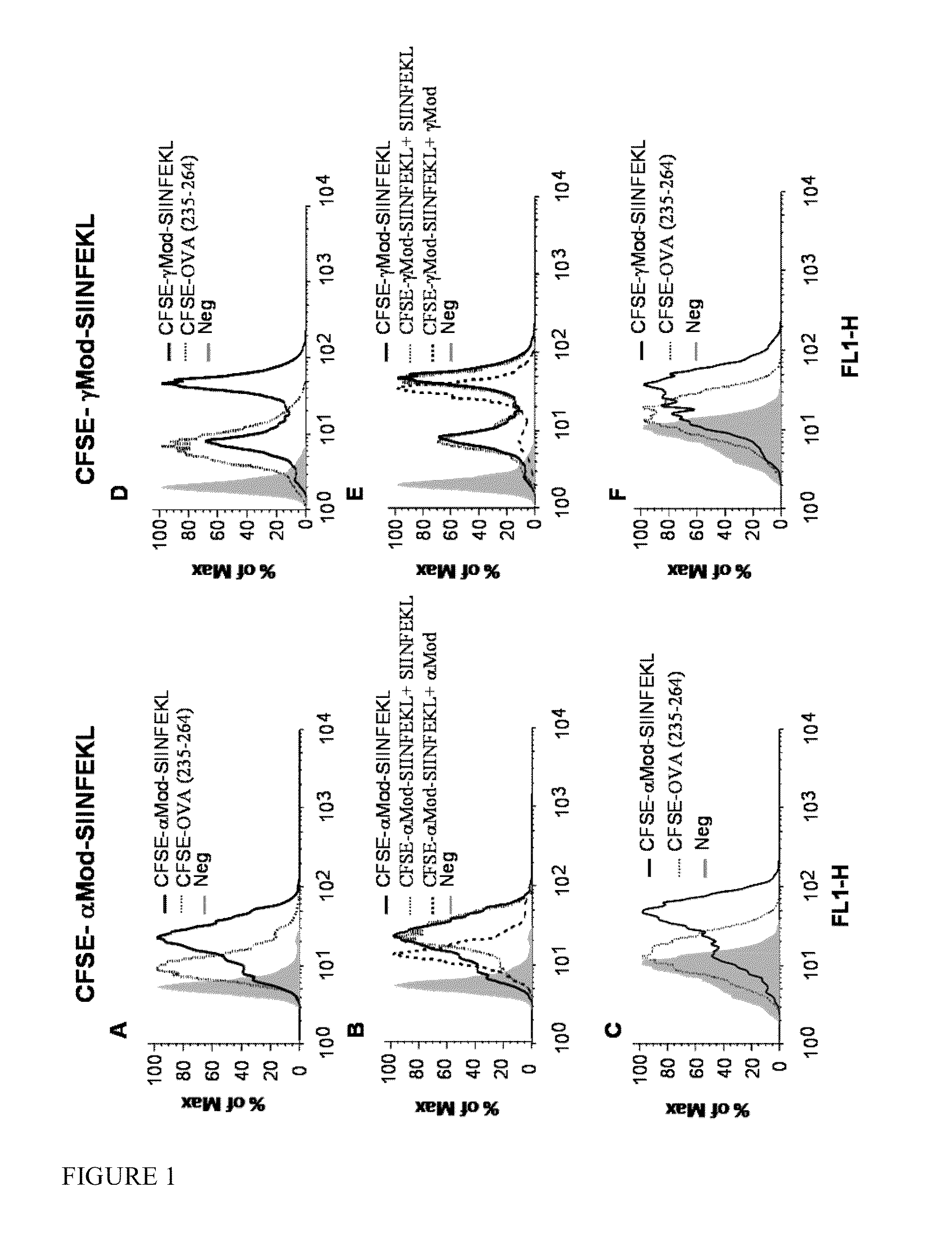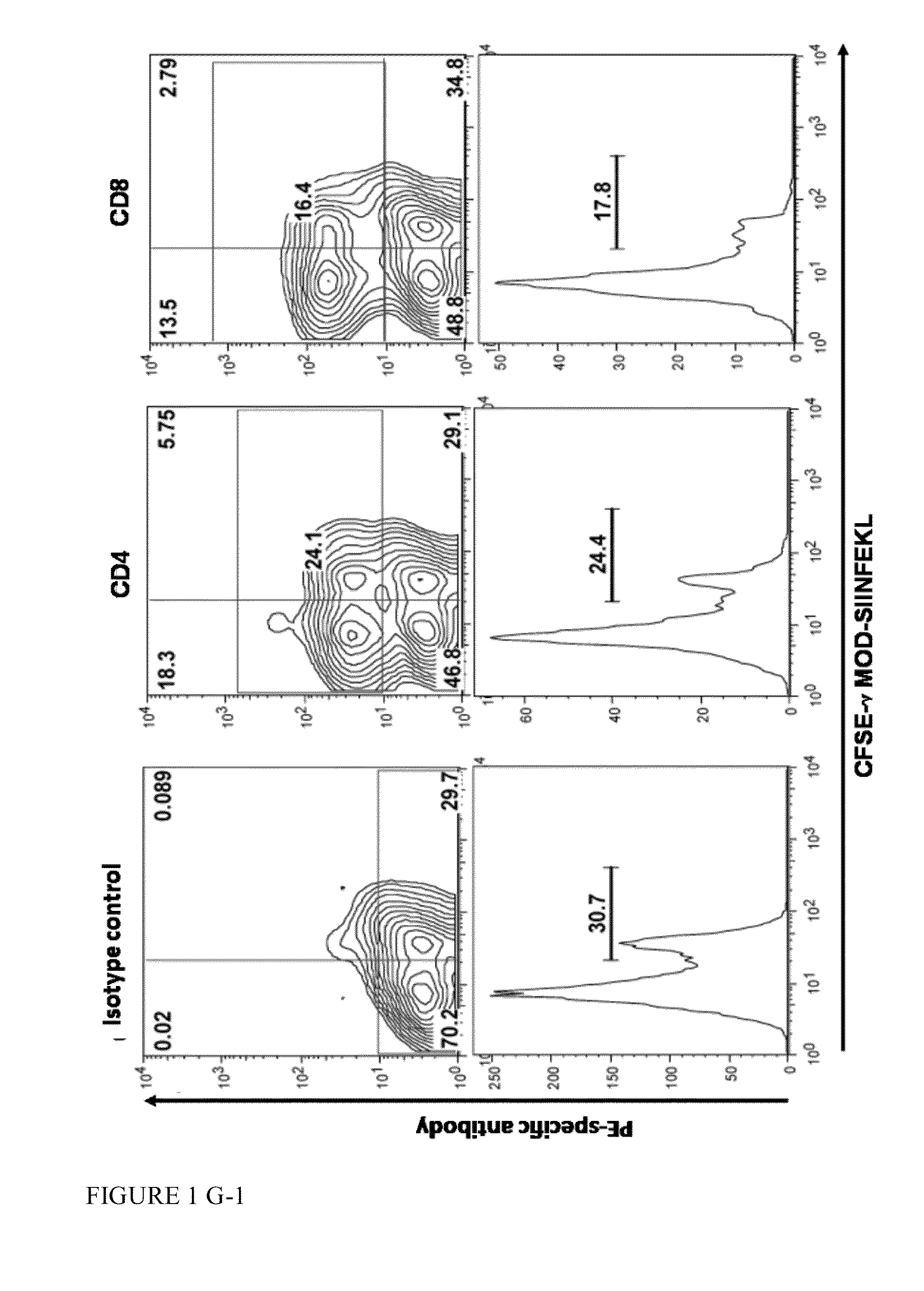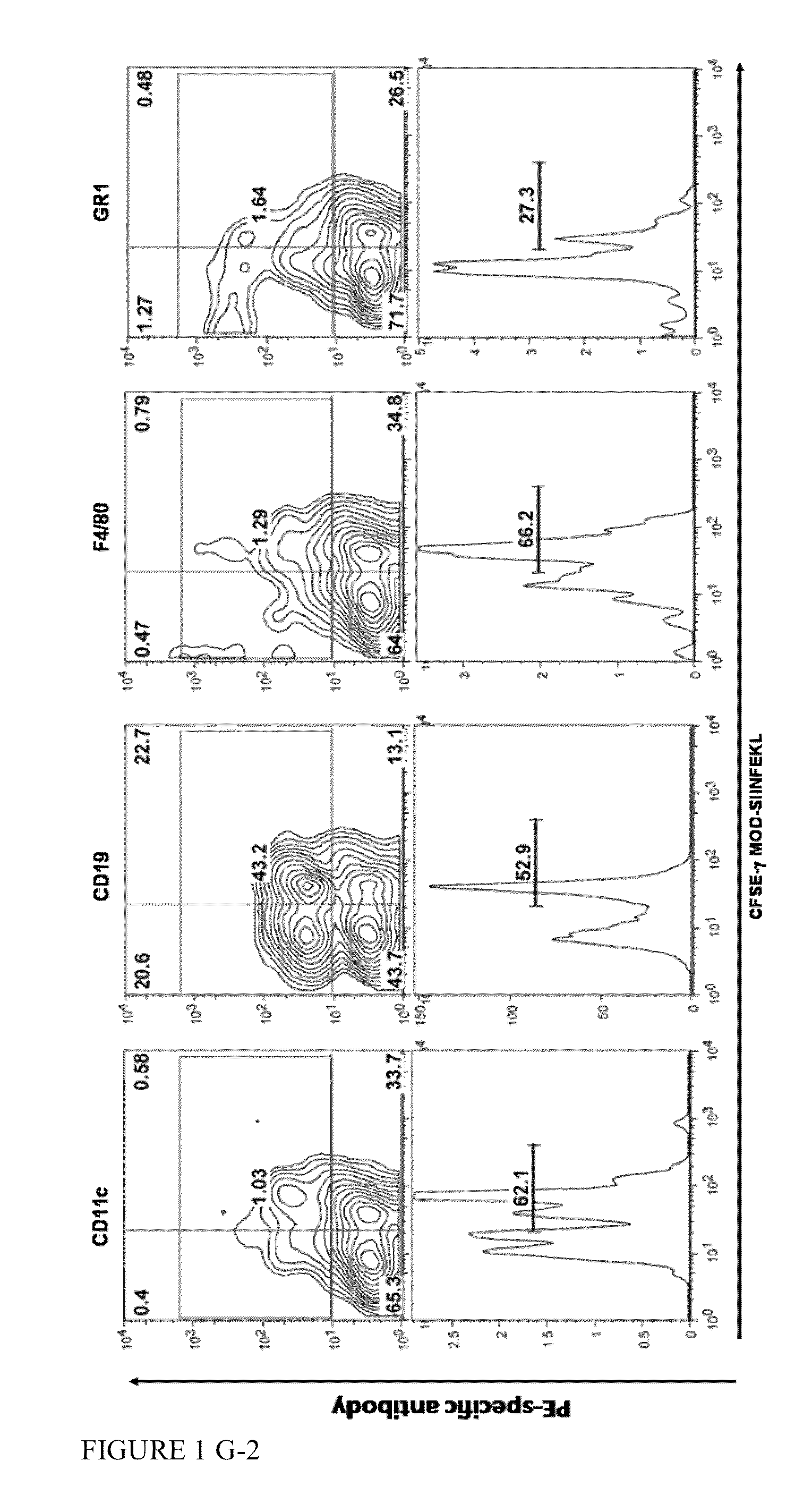Use of phenol-soluble modulins for vaccine development
a technology of phenol-soluble modulins and vaccines, applied in the field of immunology, can solve the problems of poor immunogenic capacity, ineffective antigen presentation of dendritic cells, and inability to teach covalent complexes between any of the elements
- Summary
- Abstract
- Description
- Claims
- Application Information
AI Technical Summary
Problems solved by technology
Method used
Image
Examples
example 1
Modulin Peptides are Able to Bind to the Cell Surface of the Splenocytes
Analysis of the Subpopulations Capable of Binding Modulin-Derived Peptides.
Material and Methods:
[0249]The peptides used in the present assays are shown in Table 3.
PeptideSequenceSEQ ID NO:SIINFEKLSIINFEKL44αModMADVIAKIVEIVKGLIDQFTQK 1αMod-SIINFEKLMADVIAKIVEIVKGLIDQFTQKSIINFEKL45SIINFEKL-αModSIINFEKLMADVIAKIVEIVKGLIDQFTQK46γModMAADIISTIGDLVKWIIDTVNKFKK13γMod-SIINFEKLMAADIISTIGDLVKWIIDTVNKFKKSIINFEKL47SIINFEKL-γModSIINFEKLMAADIISTIGDLVKWIIDTVNKFKK48OVA(235-264)ASGTMSMLVLLPDEVSGLEQLESIINFEKL49CFSE-γMod-SIINFEKLCFSE-MAADIISTIGDLVKWIIDTVNKFKKSIINFEKL47CFSE-OVA(235-264)CFSE-ASGTMSMLVLLPDEVSGLEQLESIINFEKL491073CVNGVCWTV50αMod-1073MADVIAKIVEIVKGLIDQFTQKCVNGVCWTV51γMod-1073MAADIISTIGDLVKWIIDTVNKFKKCVNGVCWTV52δModMSIVSTIIEVVKTIVDIVKKFKK14δMod-1073MSIVSTIIEVVKTIVDIVKKFKKCVNGVCWTV531073-δModCVNGVCWTVMSIVSTIIEVVKTIVDIVKKFKK54
[0250]Binding assays were carried out using either splenocytes (FIG. 1, panels A B, D, E and G) or bo...
example 2
α-Modulin and γ-Modulin Peptides Activate the Maturation of Dendritic Cells and Antigen Presentation
Material and Methods
[0255]Generation of Dendritic Cells from Bone Marrow.
[0256]Dendritic cells were grown from bone marrow cells. After lysing the erythrocytes with ACK lysis buffer, the cells were washed and lymphocytes and granulocytes were removed by means of incubation with a mixture of antibodies against CD4 (GK1; ATCC, Manassas, Va.), CD8 (53.6.72; ATCC), Ly-6G / Gr1 (BD-Pharmingen; San Diego Calif.) and CD45R / B220 (BD-Pharmingen), followed by rabbit supplement. The remaining cells grew in 12 culture plates in complete medium with 106 cells / ml supplemented with 20 ng / ml of mGM-CSF and 20 ng / ml of mIL-4 (both from Peprotech; London, GB). Every 2 days the medium was substituted with fresh medium containing cytokines. On day 7, non-adherent dendritic cells were collected, and cultured in the presence or absence of 50 μM of modulin peptides or of 1 μg / ml of LPS (Sigma) and incubated f...
example 3a
The Immunization with Modulin-Derived Peptides Bound to the Cytotoxic SIINFEKL Antigen and in Combination with Some TLR Ligands Induce the Activation of a Cytotoxic Response Against the Antigen. This Cytotoxic Response is Long-Lasting and Protects the Mice Against the Subcutaneous Injection of Eg.7OVa Tumor Cells
Material and Methods.
[0263]Measurement of the In Vivo Induction of Cytotoxic T Lymphocytes (CTL) (In Vivo Killing) and of IFN-γ-Producing Cells after Immunization (ELISPOT).
[0264]C57BL6 mice were intravenously immunized intravenously with 5 nmoles of the indicated peptides in combination with 50 μg of the TLR3 ligand poly I:C. In some cases, the peptides were immunized in the presence of TLR2 (peptidoglycan), TLR4 (LPS or the EDA protein) or TLR9 (CpG) ligand. Seven days after the immunization, the mice were intravenously injected with a mixture of 5×106 splenocytes, half of which had been previously labeled with a dose of 0.25 μM C and the other half with 2.5 uM CFSE and th...
PUM
| Property | Measurement | Unit |
|---|---|---|
| diameter | aaaaa | aaaaa |
| concentrations | aaaaa | aaaaa |
| concentrations | aaaaa | aaaaa |
Abstract
Description
Claims
Application Information
 Login to View More
Login to View More - R&D
- Intellectual Property
- Life Sciences
- Materials
- Tech Scout
- Unparalleled Data Quality
- Higher Quality Content
- 60% Fewer Hallucinations
Browse by: Latest US Patents, China's latest patents, Technical Efficacy Thesaurus, Application Domain, Technology Topic, Popular Technical Reports.
© 2025 PatSnap. All rights reserved.Legal|Privacy policy|Modern Slavery Act Transparency Statement|Sitemap|About US| Contact US: help@patsnap.com



